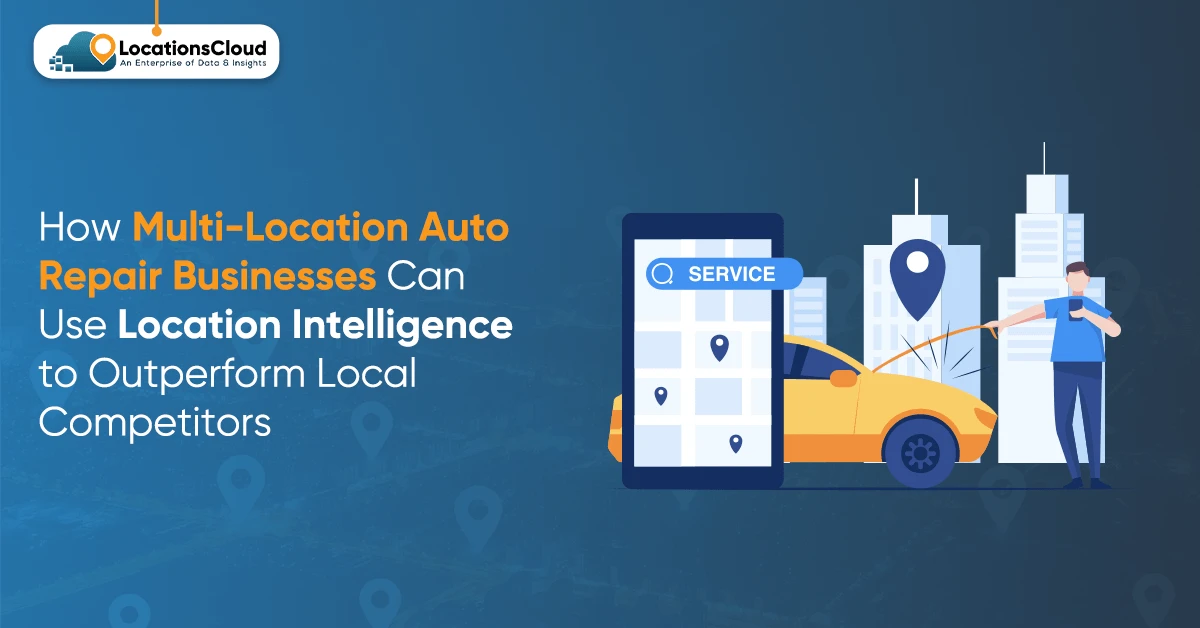
Running more than one repair shop can feel like juggling with greasy hands. One branch is slammed with tire and brake jobs, another has techs standing around waiting, and the marketing that pulls calls in one neighbourhood barely makes a ripple in another.
That is where location intelligence steps in. Instead of leaning on gut instinct, you get a clear picture of your demand, your competition, and how customers actually move through the city. With those insights, you can staff smarter, stock the right parts, and speak to each community with offers that truly connect.
What Is Location Intelligence?
Location intelligence is about taking maps, numbers, and customer data and turning them into moves that actually matter. It combines what you already know (tickets, sales, and marketing results) with what is happening outside your shop. Think demographics, road networks, traffic flow, and nearby points of interest.
The payoff is clarity. Instead of guessing who lives nearby or which routes bring drivers past your doors, you can see it clearly on a dashboard. POI data tells the story behind the numbers, showing why demand is strong in one pocket and soft in another. When managers have this view, decisions stop being about instinct and start being about confidence.
Why Location Intelligence Matters For Multi-Location Shops
Customer Demand Mapping
Customers are not spread evenly across a city. Location intelligence helps you see where they live, how far they will drive, and which corridors actually bring them in. With that knowledge, you can adjust hours, service menus, and promotions to match the way people really move.
Site Selection
Opening or relocating a branch is always a risk, but data makes it less of a gamble. Car ownership density, household income, commute routes, and local anchors like malls or business parks all point to where demand is strongest. The goal is simple. Choose neighbourhoods with healthy demand and minimal overlap with your current stores so each new site grows instead of cutting into another.
Competitor Benchmarking
Competitors leave clues. Mapping who they are, how close the shops operate, what services they push, and how customers rate them gives you a clear picture of pressure and opportunity. With that, you can position each branch with the right mix of pricing, packages, and turnaround promises.
Brand Consistency With Local Flexibility
Customers expect the same standard of service wherever they visit. Location intelligence shows where to keep things consistent and where to adapt. Intake, warranties, and communication should feel the same everywhere. Seasonal campaigns, add-ons, and loyalty offers can flex to fit the needs of each catchment.
Practical Applications You Can Use This Quarter
POI Data For Real-World Context
Shops next to retail centres often see weekend surges and need fast-turn services. Locations near warehouses may do better with fleet packages and early opening hours. POI layers highlight these patterns so you can prepare instead of reacting.
Data Collection At Scale
Set up a clean process for collecting geographic and storing data. Define the fields, create validation rules, and set refresh schedules so every branch is measured the same way. Without consistency, comparisons do not hold up.
API Data Collection For Timely Signals
Programmatic feeds can keep your listings, hours, and attributes aligned across platforms. They can also bring in traffic disruptions, weather alerts, and event schedules. With that information in hand, you can plan ahead instead of reacting at the last minute.
Data Visualisation That Leads To Action
Heat maps, drive-time catchments, and competitor overlays make patterns easy to see. When managers, marketers, and ops leaders all view the same picture, conversations get shorter and decisions come quicker.
Data Analysis And Appending
Add demographic and commuting datasets to your ticket history. This lets you see how often drivers from a specific postcode return, what their average order value looks like, and how different segments convert. With those insights, you can set stocking targets, bundle services, and plan outreach that fits each area.
Digital Shelf Analytics
Your digital shelf is how your stores show up in map results and local listings. Track rankings, ratings, photo coverage, and accuracy of details. Fix the stores that lag so call volume and direction requests keep moving up.
Turning Insights Into A Real Advantage
Location intelligence matters most when it shapes moves your rivals are not making.
- Find underserved pockets. Map gaps where car ownership is high but repair options are thin. Use local mail, community partnerships, and geo-targeted ads to build demand before adding bays or signing a lease.
- Match pricing and promotions to density. Busy commuter corridors respond to speed, like same-day diagnostics or express oil changes. Lower-density areas often prefer bundled services and family plans. Let each market set the offer instead of rolling out one network-wide deal.
- Personalise services by region. Hot climates call for A C checkup. Mountain towns benefit from suspension and brake campaigns. Fleet-heavy zones care about uptime guarantees and pickup schedules that match depot hours.
To put this into daily practice, teams need a hub that connects location data to scheduling, inventory, and reporting.
A practical way to do that is with multi-location shop management software that lets managers plan labour, stock parts, and measure performance in one place. When insights meet the tools, people already use, decisions get faster, and results improve.
Challenges And Considerations
Data Quality
Even small errors in addresses or categories can cause bad decisions. Define a single source of truth, validate inputs, and refresh regularly.
Integration Across Sources
Demographics, POIs, digital shelf signals, and internal service data all need to line up. Document how fields map and how conflicts are handled to keep branch comparisons fair.
Responsible Handling Of Customer Insights
Collect only what is needed, keep it secure, and use aggregated views whenever possible. The goal is smarter branch decisions, not building detailed customer profiles.
Balance Models With Local Knowledge
Data is powerful, but it is not everything. Ask store managers to validate what the heat maps show. The best plans come from mixing analytics with on-the-ground experience.
The Near Future Of Location Intelligence
Artificial intelligence is speeding up pattern discovery. Soon, shops will have predictive demand forecasts by day and postcode, smarter stocking suggestions before campaigns run, and alerts when competitor activity is likely to impact bookings.
Other industries like retail and healthcare are already moving this way, and auto repair will follow. Instead of only seeing store-by-store results, networks will benchmark across whole metros, spotting gaps and growth corridors with ease.
As tools improve, expect dashboards that translate complex analysis into three or four weekly actions for managers. Those who invest now will lock in an operating rhythm that is hard for rivals to copy.
Quick Playbook To Start This Month
- Map your current customers by postcode, then add drive times to see the real catchment for each shop.
- Layer POIs like malls, business parks, or depots to spot what drives demand nearby.
- Audit your digital shelf. Fix categories, photos, and hours for every branch.
- Build a single view of tickets, estimates, and average repair order by location.
- Test two location-specific offers and track lift in calls and approvals.
- Share a one-page dashboard with field managers so actions stay visible.
Conclusion
Multi-location repair networks win when every branch matches its catchment. Location intelligence gives clarity on where to grow, how to staff, and what to promote. The same approach works for other local service industries too.
Shops that lean into geographic data and the tools that bring it to life will see stronger revenue, more loyal customers, and faster decisions that competitors struggle to match.


